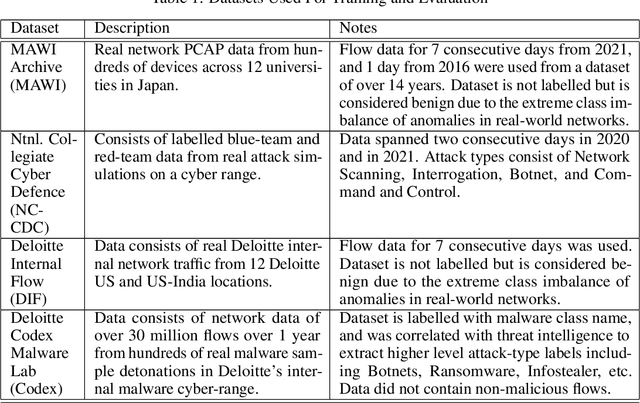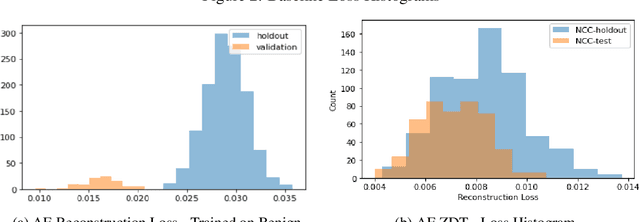Aaron Shaha
Zero Day Threat Detection Using Metric Learning Autoencoders
Nov 01, 2022Abstract:The proliferation of zero-day threats (ZDTs) to companies' networks has been immensely costly and requires novel methods to scan traffic for malicious behavior at massive scale. The diverse nature of normal behavior along with the huge landscape of attack types makes deep learning methods an attractive option for their ability to capture highly-nonlinear behavior patterns. In this paper, the authors demonstrate an improvement upon a previously introduced methodology, which used a dual-autoencoder approach to identify ZDTs in network flow telemetry. In addition to the previously-introduced asset-level graph features, which help abstractly represent the role of a host in its network, this new model uses metric learning to train the second autoencoder on labeled attack data. This not only produces stronger performance, but it has the added advantage of improving the interpretability of the model by allowing for multiclass classification in the latent space. This can potentially save human threat hunters time when they investigate predicted ZDTs by showing them which known attack classes were nearby in the latent space. The models presented here are also trained and evaluated with two more datasets, and continue to show promising results even when generalizing to new network topologies.
Lateral Movement Detection Using User Behavioral Analysis
Aug 29, 2022



Abstract:Lateral Movement refers to methods by which threat actors gain initial access to a network and then progressively move through said network collecting key data about assets until they reach the ultimate target of their attack. Lateral Movement intrusions have become more intricate with the increasing complexity and interconnected nature of enterprise networks, and require equally sophisticated detection mechanisms to proactively detect such threats in near real-time at enterprise scale. In this paper, the authors propose a novel, lightweight method for Lateral Movement detection using user behavioral analysis and machine learning. Specifically, this paper introduces a novel methodology for cyber domain-specific feature engineering that identifies Lateral Movement behavior on a per-user basis. Furthermore, the engineered features have also been used to develop two supervised machine learning models for Lateral Movement identification that have demonstrably outperformed models previously seen in literature while maintaining robust performance on datasets with high class imbalance. The models and methodology introduced in this paper have also been designed in collaboration with security operators to be relevant and interpretable in order to maximize impact and minimize time to value as a cyber threat detection toolkit. The underlying goal of the paper is to provide a computationally efficient, domain-specific approach to near real-time Lateral Movement detection that is interpretable and robust to enterprise-scale data volumes and class imbalance.
Zero Day Threat Detection Using Graph and Flow Based Security Telemetry
May 04, 2022



Abstract:Zero Day Threats (ZDT) are novel methods used by malicious actors to attack and exploit information technology (IT) networks or infrastructure. In the past few years, the number of these threats has been increasing at an alarming rate and have been costing organizations millions of dollars to remediate. The increasing expansion of network attack surfaces and the exponentially growing number of assets on these networks necessitate the need for a robust AI-based Zero Day Threat detection model that can quickly analyze petabyte-scale data for potentially malicious and novel activity. In this paper, the authors introduce a deep learning based approach to Zero Day Threat detection that can generalize, scale, and effectively identify threats in near real-time. The methodology utilizes network flow telemetry augmented with asset-level graph features, which are passed through a dual-autoencoder structure for anomaly and novelty detection respectively. The models have been trained and tested on four large scale datasets that are representative of real-world organizational networks and they produce strong results with high precision and recall values. The models provide a novel methodology to detect complex threats with low false-positive rates that allow security operators to avoid alert fatigue while drastically reducing their mean time to response with near-real-time detection. Furthermore, the authors also provide a novel, labelled, cyber attack dataset generated from adversarial activity that can be used for validation or training of other models. With this paper, the authors' overarching goal is to provide a novel architecture and training methodology for cyber anomaly detectors that can generalize to multiple IT networks with minimal to no retraining while still maintaining strong performance.
 Add to Chrome
Add to Chrome Add to Firefox
Add to Firefox Add to Edge
Add to Edge